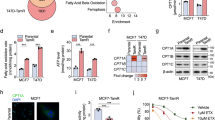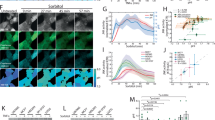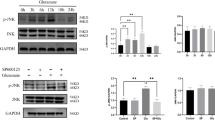Abstract
c-Jun N-terminal kinase (JNK) is activated by dual phosphorylation of both threonine and tyrosine residues in the phosphorylation loop of the protein in response to several stress factors. However, the precise molecular mechanisms for activation after phosphorylation remain elusive. Here we show that Pin1, a peptidyl-prolyl isomerase, has a key role in the JNK1 activation process by modulating a phospho-Thr-Pro motif in the phosphorylation loop. Pin1 overexpression in human breast cancer cell lines correlates with increased JNK activity. In addition, small interfering RNA (siRNA) analyses showed that knockdown of Pin1 in a human breast cancer cell line decreased JNK1 activity. Pin1 associates with JNK1, and then catalyzes prolyl isomerization of the phospho-Thr-Pro motif in JNK1 from trans- to cis-conformation. Furthermore, Pin1 enhances the association of JNK1 with its substrates. As a result, Pin1−/− cells are defective in JNK activation and resistant to oxidative stress. These results provide novel insights that, following stress-induced phosphorylation of Thr in the Thr-Pro motif of JNK1, JNK1 associates with Pin1 and undergoes conformational changes to promote the binding of JNK1 to its substrates, resulting in cellular responses from extracellular signals.
Similar content being viewed by others
Log in or create a free account to read this content
Gain free access to this article, as well as selected content from this journal and more on nature.com
or
Abbreviations
- JNK:
-
c-Jun N-terminal kinase
- Pin1:
-
peptidyl-prolyl cis/trans-isomerase
- MEF:
-
mouse embryonic fibroblast
- TCFβ1:
-
T-cell factor β1
References
Davis RJ . Signal transduction by the JNK group of MAP kinases. Cell 2000; 103: 239–252.
Johnson GL, Lapadat R . Mitogen-activated protein kinase pathways mediated by ERK, JNK, and p38 protein kinases. Science 2002; 298: 1911–1912.
Herdegen T, Waetzig V . AP-1 proteins in the adult brain: facts and fiction about effectors of neuroprotection and neurodegeneration. Oncogene 2001; 20: 2424–2437.
Rincon M, Flavell RA, Davis RJ . Signal transduction by MAP kinases in T lymphocytes. Oncogene 2001; 20: 2490–2497.
Waetzig V, Herdegen T . The concerted signaling of ERK1/2 and JNKs is essential for PC12 cell neuritogenesis and converges at the level of target proteins. Mol Cell Neurosci 2003; 24: 238–249.
Kyriakis JM, Avruch J . Mammalian mitogen-activated protein kinase signal transduction pathways activated by stress and inflammation. Physiol Rev 2001; 81: 807–869.
Bogoyevitch MA, Kobe B . Uses for JNK: the many and varied substrates of the c-Jun N-terminal kinases. Microbiol Mol Biol Rev 2006; 70: 1061–1095.
Lu KP, Hanes SD, Hunter T . A human peptidyl-prolyl isomerase essential for regulation of mitosis. Nature 1996; 380: 544–547.
Lu PJ, Zhou XZ, Shen M, Lu KP . Function of WW domains as phosphoserine- or phosphothreonine-binding modules. Science 1999; 283: 1325–1328.
Schutkowski M, Bernhardt A, Zhou XZ, Shen M, Reimer U, Rahfeld JU et al. Role of phosphorylation in determining the backbone dynamics of the serine/threonine-proline motif and Pin1 substrate recognition. Biochemistry 1998; 37: 5566–5575.
Verdecia MA, Bowman ME, Lu KP, Hunter T, Noel JP . Structural basis for phosphoserine-proline recognition by group IV WW domains. Nat Struct Biol 2000; 7: 639–643.
Stukenberg PT, Kirschner MW . Pin1 acts catalytically to promote a conformational change in Cdc25. Mol Cell 2001; 7: 1071–1083.
Wulf GM, Ryo A, Wulf GG, Lee SW, Niu T, Petkova V et al. Pin1 is overexpressed in breast cancer and cooperates with Ras signaling in increasing the transcriptional activity of c-Jun towards cyclin D1. EMBO J 2001; 20: 3459–3472.
Wulf GM, Liou YC, Ryo A, Lee SW, Lu KP . Role of Pin1 in the regulation of p53 stability and p21 transactivation, and cell cycle checkpoints in response to DNA damage. J Biol Chem 2002; 277: 47976–47979.
Zacchi P, Gostissa M, Uchida T, Salvagno C, Avolio F, Volinia S et al. The prolyl isomerase Pin1 reveals a mechanism to control p53 functions after genotoxic insults. Nature 2002; 419: 853–857.
Zheng H, You H, Zhou XZ, Murray SA, Uchida T, Wulf G et al. The prolyl isomerase Pin1 is a regulator of p53 in genotoxic response. Nature 2002; 419: 849–853.
Kasibhatla S, Tailor P, Bonefoy-Berard N, Mustelin T, Altman A, Fotedar A . Jun kinase phosphorylates and regulates the DNA binding activity of an octamer binding protein, T-cell factor beta1. Mol Cell Biol 1999; 19: 2021–2031.
Nishikata M, Suzuki K, Yoshimura Y, Deyama Y, Matsumoto A . A phosphotyrosine-containing quenched fluorogenic peptide as a novel substrate for protein tyrosine phosphatases. Biochem J 1999; 343 (Pt 2): 385–391.
Zhou XZ, Kops O, Werner A, Lu PJ, Shen M, Stoller G et al. Pin1-dependent prolyl isomerization regulates dephosphorylation of Cdc25C and tau proteins. Mol Cell 2000; 6: 873–883.
Kins S, Kurosinski P, Nitsch RM, Gotz J . Activation of the ERK and JNK signaling pathways caused by neuron-specific inhibition of PP2A in transgenic mice. Am J Pathol 2003; 163: 833–843.
Shanley TP, Vasi N, Denenberg A, Wong HR . The serine/threonine phosphatase, PP2A: endogenous regulator of inflammatory cell signaling. J Immunol 2001; 166: 966–972.
Patterson KI, Brummer T, O′Brien PM, Daly RJ . Dual-specificity phosphatases: critical regulators with diverse cellular targets. Biochem J 2009; 418: 475–489.
Szczepankiewicz BG, Kosogof C, Nelson LT, Liu G, Liu B, Zhao H et al. Aminopyridine-based c-Jun N-terminal kinase inhibitors with cellular activity and minimal cross-kinase activity. J Med Chem 2006; 49: 3563–3580.
Cowley S, Paterson H, Kemp P, Marshall CJ . Activation of MAP kinase kinase is necessary and sufficient for PC12 differentiation and for transformation of NIH 3T3 cells. Cell 1994; 77: 841–852.
Huang S, Jiang Y, Li Z, Nishida E, Mathias P, Lin S et al. Apoptosis signaling pathway in T cells is composed of ICE/Ced-3 family proteases and MAP kinase kinase 6b. Immunity 1997; 6: 739–749.
Kallunki T, Deng T, Hibi M, Karin M . c-Jun can recruit JNK to phosphorylate dimerization partners via specific docking interactions. Cell 1996; 87: 929–939.
Mooney LM, Whitmarsh AJ . Docking interactions in the c-Jun N-terminal kinase pathway. J Biol Chem 2004; 279: 11843–11852.
Fischer G, Aumuller T . Regulation of peptide bond cis/trans isomerization by enzyme catalysis and its implication in physiological processes. Rev Physiol Biochem Pharmacol 2003; 148: 105–150.
Basu A, You SA, Haldar S . Regulation of Bcl2 phosphorylation by stress response kinase pathway. Int J Oncol 2000; 16: 497–500.
Yaffe MB, Schutkowski M, Shen M, Zhou XZ, Stukenberg PT, Rahfeld JU et al. Sequence-specific and phosphorylation-dependent proline isomerization: a potential mitotic regulatory mechanism. Science 1997; 278: 1957–1960.
Park JE, Park BC, Kim HA, Song M, Park SG, Lee DH et al. Positive regulation of apoptosis signal-regulating kinase 1 by dual-specificity phosphatase 13A. Cell Mol Life Sci 2010; 67: 2619–2629.
Acknowledgements
We thank Roger Davis, Insug Kang, Jong-Tae Kim, and Seung-Chul Choi for generously providing reagents or technical assistance. This work was supported by the Korea Science and Engineering Foundation (KOSEF) grant funded by the Korea government (MEST; no. 2011-0003139) and by a grant of the Korea Health 21 R&D Project, Ministry of Health & Welfare, Republic of Korea (A01-0385-A70604-07M7-00040B).
Author information
Authors and Affiliations
Corresponding authors
Ethics declarations
Competing interests
The authors declare no conflict of interest.
Additional information
Edited by L Greene
Supplementary Information accompanies the paper on Cell Death and Differentiation website
Supplementary information
Rights and permissions
About this article
Cite this article
Park, J., Lee, J., Park, S. et al. A critical step for JNK activation: isomerization by the prolyl isomerase Pin1. Cell Death Differ 19, 153–161 (2012). https://doi.org/10.1038/cdd.2011.82
Received:
Revised:
Accepted:
Published:
Issue date:
DOI: https://doi.org/10.1038/cdd.2011.82
Keywords
This article is cited by
-
FAF1 mediates necrosis through JNK1-mediated mitochondrial dysfunction leading to retinal degeneration in the ganglion cell layer upon ischemic insult
Cell Communication and Signaling (2018)
-
cJun N-terminal kinase (JNK) phosphorylation of serine 36 is critical for p66Shc activation
Scientific Reports (2016)
-
Proline isomerisation as a novel regulatory mechanism for p38MAPK activation and functions
Cell Death & Differentiation (2016)
-
The isomerase PIN1 controls numerous cancer-driving pathways and is a unique drug target
Nature Reviews Cancer (2016)
-
Prolyl isomerase Pin1 in cancer
Cell Research (2014)



